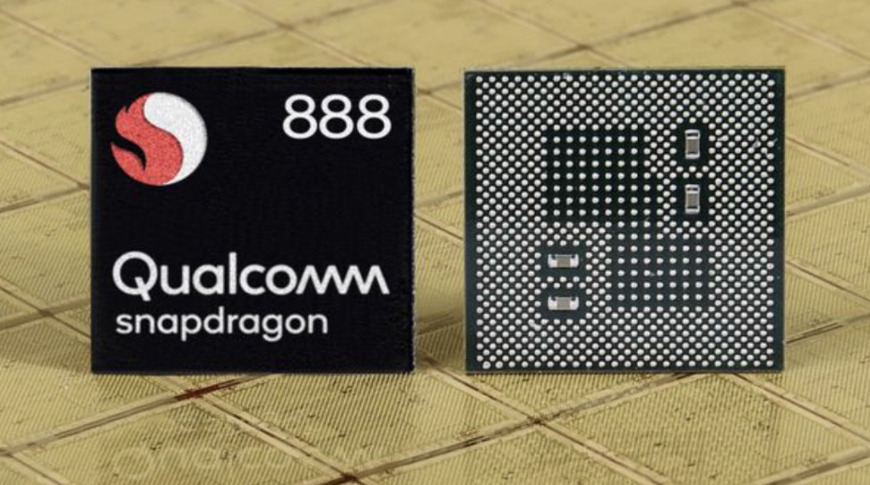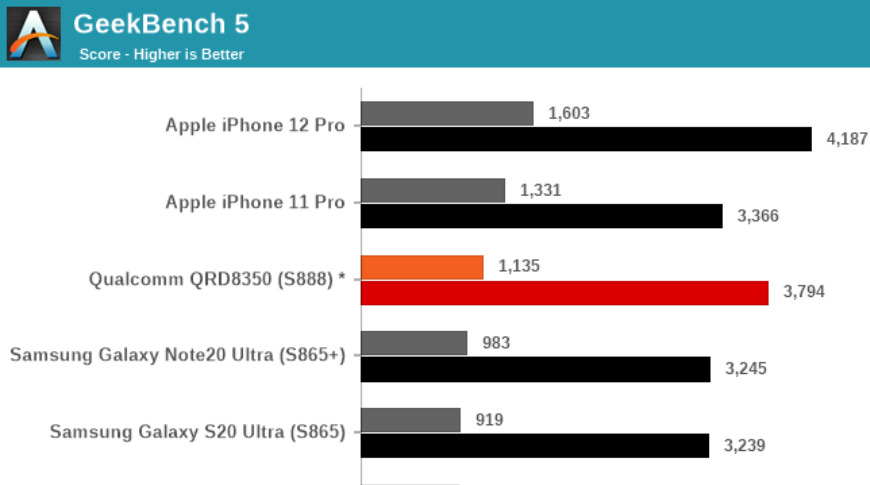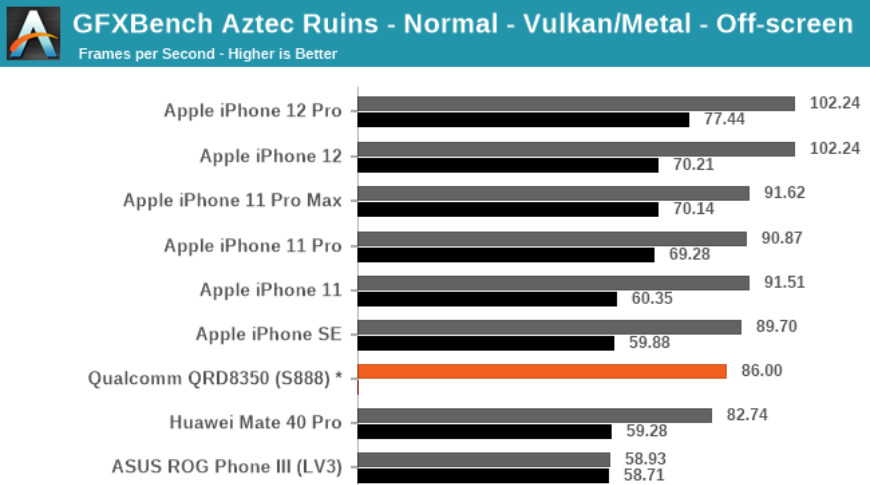Qualcomm has provided benchmarks for its Snapdragon 888 flagship system on a chip, and they show lackluster performance versus the iPhone 12, and even lose out to older iPhones running the A13.
Qualcomm announces its new processors every year in mid-December to preempt their arrival in products at CES. In 2020, the announcements were made online, and benchmarks were provided by the company.
The Snapdragon 888 performed well when compared to the current lineup of Android devices like the Samsung Galaxy Note 20 Ultra, but failed to surpass Apple's latest iPhones. Even the year-ago iPhone 11 lineup and iPhone SE running the A13 processor outperformed the new Qualcomm processor.
Qualcomm are using some powerful new technologies in its Snapdragon 888 making it a very competitive processor. It uses the Cortex-X1 as part of a similar big-little design that the A14 implements. The new SoC also includes the Adreno 660 GPU which is expected to perform 35% better than previous GPUs.
Anandtech received the benchmarks from Qualcomm and compared them to the known scores of other products. First is Geekbench 5, the well known CPU benchmarking tool that provides scores for single-core and multi-core operation.
The single-core score increased year-over-year by about 23.5% from 919 to 1135, which comes shy of the iPhone 11 Pro running the A13 which scored a 1,331. The multi-core score improved by 16.9% to achieve a score of 3,794 which overtakes the A13 processor's score of 3,366 but doesn't come close to the A14's 4,187 score.
The GPU benchmark shows even less promising results. Using GFXBench results, Anandtech laid out the graphics scores for various products vs the new Snapdragon 888.
The scores are reported in peak frames per second, and the Snapdragon 888 handily beat all of the current Android flagships by as much as 55%. This could be an anomaly, but it is what was reported by Qualcomm, who previously suggested the graphics improvements would be around 35%.
When compared to the iPhone 12 and the iPhone 11 lineup, it didn't fare so well. It can be assumed that since these are peak results during the test that the Snapdragon may perform differently under extended load, but those tests will have to wait until reviewers get their hands on devices running the processor.
Qualcomm released other results like AI performance tests, but those are not comparable to the iPhone processors. Apple does have powerful neural engines in its A-series chips, not to mention its M1 processor, but those have not been properly benchmarked for comparison.
 Wesley Hilliard
Wesley Hilliard









-m.jpg)






 Christine McKee
Christine McKee
 Marko Zivkovic
Marko Zivkovic
 Mike Wuerthele
Mike Wuerthele

 Amber Neely
Amber Neely
 Sponsored Content
Sponsored Content











16 Comments
Impressive work by Apple.
The 888 has a triple tier processor, with a single 5nm Cortex-X1 at the top of the heap.
Here's a comparison of the 7nm Lightning cores in the A13 to a variety of competitors including the 5nm Cortex-X1: https://www.anandtech.com/show/15875/apple-lays-out-plans-to-transition-macs-from-x86-to-apple-socs.
Note that the Lightning cores beat the Cortex-X1 in all areas but floating point, and there are two Lightning cores in the A13 Bionic (used in the iPhone 11).
Since then, Apple has shrunk the Firestorm high performance cores in the A14 down to 5nm and improved the speed by an additional 20% and there are two of them in the A14 Bionic. There are four Firestorm cores in the M1 which are even faster, being clocked at 3.2 ghz, so the fastest single core in the 888 trails well behind the Firestorm cores in either the A14 or M1.
Apple's chip beats out Qualcomm chips? Wake me up in a few years when Qualcomm actually does something.
From being behind the current generation but ahead of the previous generation to now being behind the current and previous generation... in a few years will the newest of Android processors be behind three generations of Apple processors? That’s the direction we’re heading.